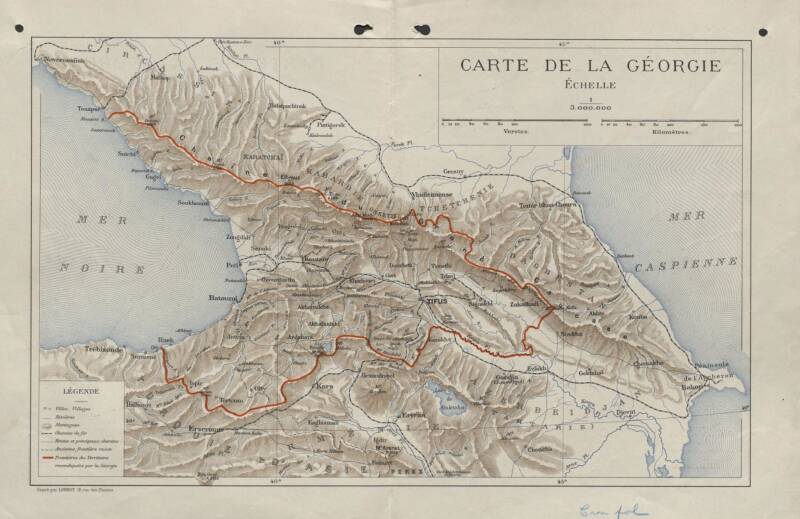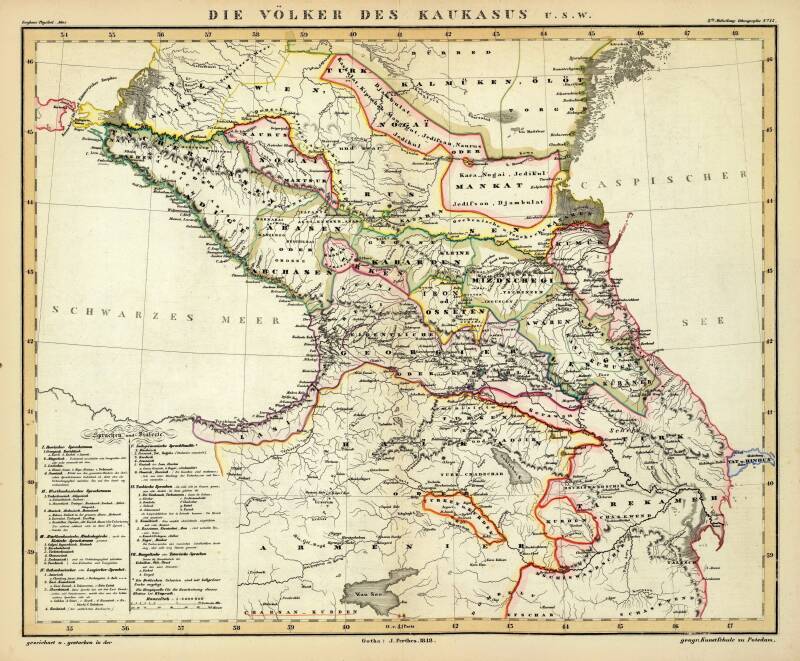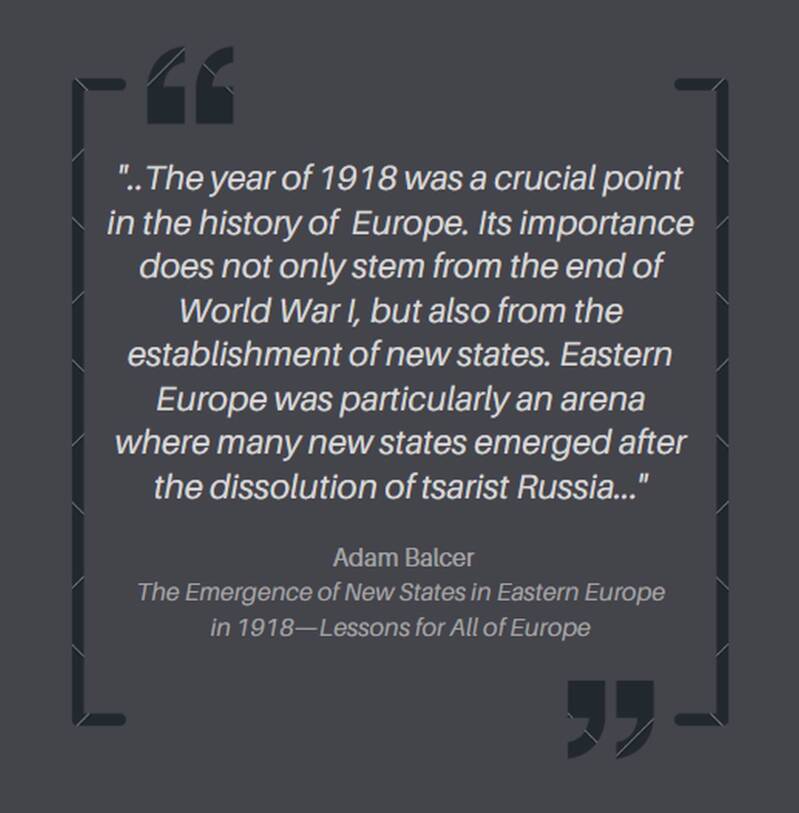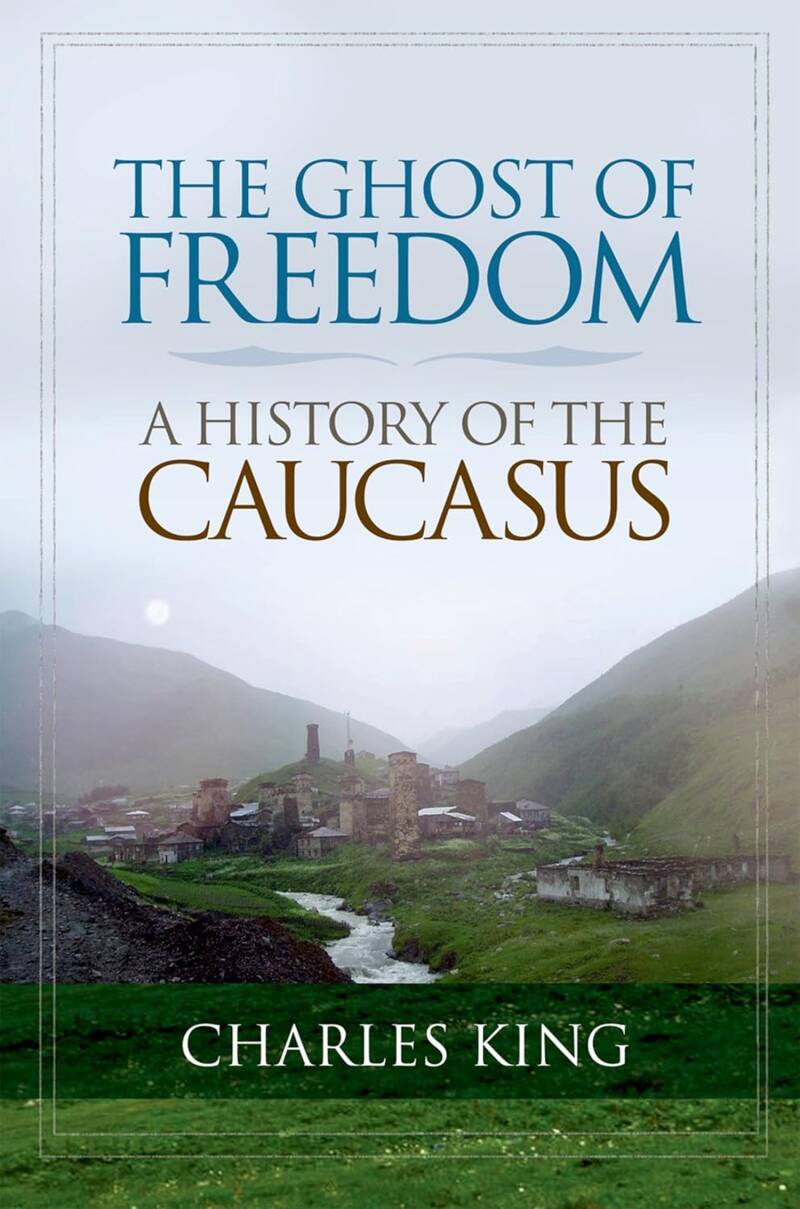Brief independence, lasting impact
Short-Lived Sovereignties That Shaped Caucasus Geopolitics Forever
In the turbulent years following the Russian Revolution of 1917, a wave of independence movements swept across the territories of the former Russian Empire, culminating in the brief yet significant emergence of several independent republics in the Caucasus region.
The Mountainous Republic of the Northern Caucasus, the Democratic Republic of Georgia, the First Republic of Armenia, and the Azerbaijan Democratic Republic all declared their independence in 1918, each striving to establish sovereignty amid the chaos of the Russian Civil War and the aftermath of the First World War.
Georgians pictured in traditional dress, early 1900's(?).
https://www.theapricity.com/forum/showthread.php?340801-Old-Photos-From-Caucasus
A traditional Azerbaijan game named "Qız-Qov". "Qız-Qov" is a traditional Azerbaijani game where boys chase girls in a playful race. Symbolizing youthful energy and courtship, the game is often part of festive gatherings, reflecting the vibrant cultural heritage and social dynamics of rural Azerbaijani communities.
https://www.theapricity.com/forum/showthread.php?340801-Old-Photos-From-Caucasus
...highlighted the deep-rooted aspirations...
The Mountainous Republic of the Northern Caucasus, established in May 1918, represented a coalition of diverse ethnic groups seeking autonomy from the collapsing Russian Empire.
Although short-lived, its existence highlighted the deep-rooted aspirations for self-determination among the peoples of the North Caucasus.
Similarly, the Democratic Republic of Georgia, also founded in May 1918, attempted to carve out a democratic and pluralistic state amidst the regional instability, only to be subsumed by Soviet forces a few years later.
Armenian Wrestlers, date unknown. In the early 1900s(?), Armenian culture thrived in its ancient traditions, with a strong emphasis on family, religion, and craftsmanship. Despite facing persecution, Armenians preserved their rich heritage through vibrant music, literature, and religious practices.
https://www.theapricity.com/forum/showthread.php?340801-Old-Photos-From-Caucasus
...the first secular Muslim-majority republic...
Meanwhile, the First Republic of Armenia and the Azerbaijan Democratic Republic emerged as neighbouring states with contrasting challenges.
Armenia, facing external pressures from Ottoman forces and internal strife, struggled to maintain its sovereignty, eventually succumbing to Sovietization.
Azerbaijan, on the other hand, distinguished itself as the first secular Muslim-majority republic, but it too was unable to withstand the Soviet advance.
Tatar bazaar and with the Metekhi Orthodox church seen on the cliff in Tbilisi, Georgia, 19th century.
...continue to influence the region's modern political dynamics...
These republics' brief existences reflect broader geopolitical struggles in the Caucasus, where the intersection of ethnic identities, national ambitions, and imperial interests created a complex and often volatile political landscape.
The legacies of these states continue to influence the region's modern political dynamics, underscoring the enduring impact of this pivotal moment in history.
A Historical and Political Hotspot
The Caucasus region, a mosaic of mountains and valleys, has long been home to an extraordinary tapestry of ethnic groups, each with its own language, culture, and history.
This diversity, while a testament to the region's rich heritage, has also been a source of tension and conflict, particularly in the volatile years following the First World War and leading up to the Second World War.
After the fall of the Russian Empire in 1917, the Caucasus became a cauldron of competing nationalisms. Armenians, Azerbaijanis, and Georgians, alongside smaller ethnic groups such as the Chechens, Ossetians, and Abkhazians, all sought to carve out their own states amidst the chaos of the Russian Civil War.
The brief independence of Armenia, Azerbaijan, and Georgia between 1918 and 1920 highlighted the region's deep-seated ethnic divisions.
Each of these fledgling states had internal minority populations that often harbored different loyalties, leading to internal strife and border conflicts.
Russian soldiers in a trench during the Kerensky offensive, 1917. The Kerensky Offensive was a failed Russian military campaign, demoralized troops and deepened unrest, weakening the Provisional Government. Its failure accelerated the Russian Empire's collapse, paving the way for the Bolshevik Revolution later that year.
Ethnic Map of Caucasus, cca. 1890. The Caucasus region's complex ethnic history is a tapestry of diverse cultures and languages, marked by centuries of conflict and coexistence. Ethnic rivalries, border disputes, and imperial ambitions have shaped its volatile, ever-shifting geopolitical landscape.
Berghaus Physical Atlas
...laying the groundwork for future unrest...

The situation was particularly dire in Nagorno-Karabakh, a predominantly Armenian enclave within Azerbaijan, which became a flashpoint for conflict.
Meanwhile, the Georgian-Abkhazian and Georgian-South Ossetian tensions simmered beneath the surface, laying the groundwork for future unrest.
The Soviets, reasserting control over the region by the early 1920s, attempted to manage these ethnic tensions through a policy of divide and rule.
They redrew borders, often placing ethnic groups within the administrative boundaries of their rivals, sowing seeds of discord that would later erupt into conflict.
Armenian militia marching through the streets of Baku, 1918. Armenian militias played a crucial role in the formation of the First Armenian Republic in 1918, defending the fledgling state against external threats, particularly Ottoman forces, while also maintaining internal order during a period of significant political and social upheaval.
https://armenian-history.com/first-republic-of-armenia-1918-1920/#bwg1/63
...aware of the Caucasus' strategic importance...
In the lead-up to the Second World War, the Caucasus was a region of simmering instability.
The Soviet Union's tight grip on the region masked underlying ethnic tensions, but these tensions did not disappear. Instead, they were suppressed, only to resurface violently in the late 20th century.
The Soviets, aware of the Caucasus' strategic importance—particularly its oil fields—used the region as a buffer zone against potential invasions, but the ethnic fault lines they manipulated for control would ultimately prove to be the region's Achilles' heel.
The Caucasus' ethnic complexity, therefore, was not just a backdrop to its history but a driving force in its political and military struggles, making it a key player in the geopolitical drama of the 20th century.
Mountainous Republic of the Northern Caucasus established, 11th May 1918
The Mountainous Republic of the Northern Caucasus (MRNC), also known as the United Republics of the North Caucasus, Mountain Republic, or the Republic of the Mountaineers, was a state in Eurasia that existed from 1918 to 1919 during the Russian Civil War.
It emerged as a coalition of various Caucasian ethnic groups, including the Abkhazians, Abazins, Circassians, Chechens, Karachays, Ossetians, Balkars, Ingush, and Dagestanis.
Territories controlled by the Mountain Republic.
https://en.wikipedia.org/wiki/Mountainous_Republic_of_the_Northern_Caucasus
...MRNC declared independence from the Russian Empire...
Tapa Abdul Mejid Tchermoev, Prime Minister of the Mountainous Republic of the Northern Caucasus, 11 May 1918 – December 1918.
The MRNC encompassed the former territories of Terek Oblast and Dagestan Oblast of the Russian Empire.
These areas now correspond to the present-day republics of Chechnya, Ingushetia, North Ossetia–Alania, Kabardino-Balkaria, Dagestan, and parts of Stavropol Krai in the Russian Federation.
Covering approximately 430,874 square kilometers (166,361 sq mi), the MRNC had a population of around 11.2 million. Its capital moved from Vladikavkaz to Nazran, and finally to Temir-Khan-Shura.
The MRNC declared independence from the Russian Empire following the February Revolution and before the Russian Civil War.
The Russian Volunteer Army captured the state in 1919, leading to its dissolution. In September 1919, the North Caucasian Emirate was declared as the successor to the Mountain Republic.
However, Soviet Russia captured the area in August 1920, which sparked an uprising.
In April 1921, the Bolsheviks established the Mountain Autonomous Soviet Socialist Republic within the RSFSR, but resistance continued until 1925.
Democratic Republic of Georgia established, 26th May 1918
The Democratic Republic of Georgia (DRG) was the first modern republic of Georgia, existing from May 1918 to February 1921.
It emerged after the Russian Revolution of 1917, which led to the collapse of the Russian Empire, enabling former Russian territories to declare independence.
Unlike Bolshevik Russia, DRG was governed by a moderate, multi-party system led by the Georgian Social Democratic Party (Mensheviks).

Map of borders submitted by the Democratic Republic of Georgia to the Paris Peace Conference in 1921.
...Soviet dominance rendered continued recognition impractical...
Initially a protectorate of the German Empire, DRG faced partial British occupation after Germany's defeat in the First World War.
British troops were stationed to counter a potential Bolshevik invasion but left in 1920 following the Treaty of Moscow, where Russia recognized Georgia's independence in exchange for DRG not hosting anti-Russian forces.
Without Western European support, the Bolshevik Red Army invaded in February 1921, leading to DRG's defeat and the establishment of Soviet rule by March.
The Georgian government, led by Prime Minister Noe Zhordania, relocated to France, continuing in exile.
France, Britain, Belgium, and Poland recognized this government as the legitimate authority of Georgia until the 1930s when Soviet dominance rendered continued recognition impractical.
Noe Zhordania, the chairman of the second and the third government of the Republic.
Fragments of the Constitution of Georgia adopted by the Constituent Assembly of Georgia on 21st February 1921.
...one of the first European nations to grant women the right to vote...
Despite its brief existence, DRG remains an inspiration for modern Georgia due to its democratic and pluralistic legacy.
It was one of the first European nations to grant women the right to vote, a right enshrined in its constitution. DRG also elected women to its parliament and included representatives from diverse ethnic backgrounds, including Germans, Russians, Armenians, Azerbaijanis, and Jews.
Additionally, DRG established Georgia's first university, fulfilling a longstanding aspiration of Georgian intellectuals previously thwarted by Imperial Russian rule.
Map of the Soviet Invasion of Georgia, 1921. The Soviet invasion marked the end of the short-lived Georgian Democratic Republic. The Red Army swiftly overran the country, incorporating it into the Soviet Union, crushing hopes for Georgian independence and igniting lasting resistance.
Andrew Andersen & George Partskhaladze
http://www.conflicts.rem33.com/images/Georgia/Soviet_Georgian_War21_E3_files/image002.jpg
First Republic of Armenia declares independence, 28th May 1918
The First Republic of Armenia, known as the Republic of Armenia, was an independent state from May 1918 to December 1920. Established after the dissolution of the Transcaucasian Democratic Federative Republic, it was the first Armenian state since the Middle Ages, with Yerevan as its capital.
Initially, Armenia controlled a small area around Lake Sevan due to an Ottoman invasion during the Caucasus campaign. After the Armistice of Mudros, Armenia expanded its borders, leading to a brief border conflict with Georgia.
The first winter was harsh, with hundreds of thousands of genocide refugees dying from starvation or exposure.
In spring 1919, with British support, Armenia incorporated Kars and Nakhchivan, tripling its size. However, control over these regions was lost during Muslim uprisings in the summer of 1919.
The Declaration of Independence of Armenia, 1918.
https://armenian-history.com/first-republic-of-armenia-1918-1920/

Official map of the First Republic presented at the Paris Peace Conference.
...Turkish forces invaded, leading to Armenia's partition and sovietisation by the Russian SFSR...
Republic of Armenia passport issued in Constantinople to two teenagers entering Canada in 1920.
Image scanned from "Polyphony: The Bulletin of the Multicultural History Society of Ontario - Armenians in Ontario, Fall/Winter 1982, Vol.4, No. 2"
By late 1919, Zangezur was attacked by Azerbaijan, and in March 1920, an Armenian uprising in Nagorno-Karabakh ended with its sovietisation in April.
In August 1920, the Treaty of Sèvres promised Armenia an additional 40,000 square miles in Western Armenia, but it was never implemented.
Later in 1920, Turkish forces invaded, leading to Armenia's partition and sovietisation by the Russian SFSR, which established the Armenian Soviet Socialist Republic. An anti-Bolshevik revolt occurred from February to July 1921.
During its brief existence, Armenia established diplomatic relations with 40 countries, gained de jure recognition, held parliamentary elections, and founded its first university.
The government was dominated by the Dashnak party (ARF), though initial cabinet positions were shared with the Armenian Populist Party and Social Revolutionaries.
The Armenian delegation at the Paris Peace Conference, headed by Avetis Aharonyan's cabinet. Standing from left to right: Simon Hakobian, Simon Narinian, Artavazd Hanmian, Hamazasp Ohanjanian, Manuk Hambardzumian, Garegin Pastrmajian and Zatik Matikian. Sitting from left to right: Levon Shant, Astvatsatur Khachatrian, Nikol Matinian, Avetis Aharonian, Armenak Barseghian and Hakob Nevruz.
Azerbaijan Democratic Republic declares independence, 28th May 1918.
The Azerbaijan Democratic Republic (ADR), also known as the Azerbaijan People's Republic, was the first secular democratic republic in the Turkic and Muslim worlds.
Founded by the Azerbaijani National Council in Tiflis on the 28th May 1918, after the collapse of the Transcaucasian Democratic Federative Republic, the ADR existed until April 28, 1920.
Its borders were with Russia to the north, Georgia to the northwest, Armenia to the west, and Iran to the south, with a population of around 3 million.

Ganja served as the temporary capital since Baku was under Bolshevik control.
The name "Azerbaijan" was chosen by the leading Musavat party for political reasons, despite historically referring to a region in northwestern Iran.
Map of the Azerbaijan Democratic Republic with territorial claims and disputed areas. The Azerbaijan Democratic Republic, founded in 1918, was the first secular democratic republic in the Muslim world, granting women equal rights and establishing Baku State University before its 1920 Sovietisation.
...One of the ADR's significant achievements was granting women equal political rights...
A founder and Speaker of the Republic, Mammad Amin Rasulzade is widely regarded as the national leader of Azerbaijan.
https://en.wikipedia.org/wiki/Azerbaijan_Democratic_Republic
The ADR established a parliamentary government based on universal, free, and proportionate representation, with the Parliament being the supreme state authority and the Council of Ministers accountable to it. Fatali Khan Khoyski became the first prime minister.
The parliament included members from various parties such as Musavat, Ahrar, Ittihad, and Muslim Social Democrats, as well as representatives from Armenian, Russian, Polish, German, and Jewish minorities.
Many parliament members supported Pan-Islamist and Pan-Turkist ideas.
One of the ADR's significant achievements was granting women equal political rights, making Azerbaijan one of the first countries globally and the first majority-Muslim nation to do so.
Additionally, the ADR founded Baku State University, the first modern university in Azerbaijan, marking another major accomplishment during its brief existence.
Republic of Azerbaijan and its Territorial Claims in 1919. Between 1918 and 1920, the Republic of Azerbaijan sought to assert territorial claims over regions like Nagorno-Karabakh, Nakhchivan, and Zangezur, leading to conflicts with neighboring Armenia and the brief, unstable independence of both states.
Conclusion
The brief independence of the Mountainous Republic of the Northern Caucasus, Democratic Republic of Georgia, First Republic of Armenia, and Azerbaijan Democratic Republic in 1918 marked significant, albeit fleeting, assertions of national identity amidst the disintegration of the Russian Empire.
These newly established states, born out of the chaos of the Russian Civil War and the First World War, ultimately succumbed to Soviet domination, yet their existence laid bare the fragility of regional stability in the Caucasus.
The collapse of these republics and the subsequent Sovietization contributed to long-standing ethnic tensions and territorial disputes that would simmer throughout the interwar period.
The Russian Civil War tore society apart and destroyed the mass social movement that had carried out the 1917 revolution. The chaos of the Russian Civil War in 1918 weakened central authority, creating a power vacuum in the Caucasus. This allowed regional leaders to declare independence, leading to the formation of new states like Georgia, Armenia, and Azerbaijan.
https://www.military-history.org/cover-feature/the-russian-civil-war.htm
...unresolved conflicts, particularly those involving ethnic minorities and border disputes, would later be exploited by Nazi Germany...
As the Soviet Union solidified its control over the Caucasus, the repression of nationalist movements and the forced integration of these diverse regions into a single ideological entity sowed seeds of resentment and unrest.
These unresolved conflicts, particularly those involving ethnic minorities and border disputes, would later be exploited by Nazi Germany during the Second World War as part of their strategy to destabilize the Soviet Union from within.
The events of 1918-1920, therefore, not only shaped the immediate political landscape of the Caucasus but also contributed to the geopolitical instability that played a role in the outbreak and dynamics of the Second World War.
A map of Southern Causasia in 1919. The emergence of new, independent republics in the wake of the Russian Revolution dramatically impacted on the map of that region.
Further reading
"Armenian History: A Captivating Guide to the History of Armenia and the Armenian Genocide" provides an engaging overview of Armenia's rich and complex history, from its ancient origins to modern times. The book delves into key events, cultural developments, and the tragic Armenian Genocide during the First World War. It offers readers a concise yet thorough understanding of Armenia's past, highlighting the resilience of its people and the enduring significance of their cultural heritage.
"A Concise History of Azerbaijan" by Jahangir Zeynaloglu traces the rich historical journey of Azerbaijan, focusing on the evolution of Azerbaijani Turkic dynasties from the Middle Ages to the establishment of the first Turkic republic. The book provides an insightful overview of Azerbaijan's cultural and political development, highlighting key historical figures, events, and the nation's transition into modern statehood, making it an essential read for understanding Azerbaijan's unique heritage and identity.
"The History of Georgia: Mysteries of the Caucasus" by Akaki Bunt offers a captivating exploration of Georgia's rich and enigmatic past. The book delves into the nation's ancient origins, strategic importance in the Caucasus, and its complex cultural and political history. It uncovers the mysteries surrounding Georgia's historical events and influential figures, providing readers with a deep understanding of how this resilient nation has shaped, and been shaped by, the turbulent history of the region.
"The Russian Revolution" by Sheila Fitzpatrick provides a detailed and insightful analysis of the 1917 Russian Revolution, exploring its causes, key events, and profound impact on Russia and the world. Fitzpatrick examines the social, political, and economic factors that fueled the revolution, the roles of Lenin and the Bolsheviks, and the subsequent transformation of Russian society under Soviet rule. The book offers a nuanced understanding of this pivotal moment in history, making it essential reading for students and history enthusiasts alike.

"The Caucasus: An Introduction" by Thomas de Waal offers a comprehensive overview of the Caucasus region, exploring its complex history, diverse cultures, and ongoing geopolitical challenges. De Waal examines the intricate relationships between the various ethnic groups, the legacy of Soviet rule, and the region's strategic significance. The book provides readers with an accessible yet detailed understanding of the Caucasus, highlighting the factors that have shaped its past and continue to influence its present and future.
"The Ghost of Freedom: A History of the Caucasus" by Charles King offers a compelling narrative of the Caucasus region's tumultuous history, blending detailed historical analysis with vivid storytelling. King explores the region's diverse cultures, complex political dynamics, and the struggles for independence that have defined its past. The book delves into the enduring legacies of empire, conflict, and identity, providing a rich understanding of the forces that have shaped the Caucasus and its ongoing quest for freedom.
Sources:
https://en.wikipedia.org/wiki/Democratic_Republic_of_Georgia
https://en.wikipedia.org/wiki/Mountainous_Republic_of_the_Northern_Caucasus
https://armenian-history.com/first-republic-of-armenia-1918-1920/
https://en.wikipedia.org/wiki/First_Republic_of_Armenia
Image scanned from "Polyphony: The Bulletin of the Multicultural History Society of Ontario - Armenians in Ontario, Fall/Winter 1982, Vol.4, No. 2"
https://commons.wikimedia.org/wiki/User:Golden
https://en.wikipedia.org/wiki/Azerbaijan_Democratic_Republic
Berghaus Physical Atlas
https://www.edmaps.com/html/azerbaijan_1919_1.html
Andrew Andersen & George Partskhaladze
http://www.conflicts.rem33.com/images/Georgia/Soviet_Georgian_War21_E3_files/image002.jpg
https://www.theapricity.com/forum/showthread.php?340801-Old-Photos-From-Caucasus
https://armenian.usc.edu/on-origins-of-the-caucasus-region/
https://armenian-history.com/first-republic-of-armenia-1918-1920/
https://en.wikipedia.org/wiki/Tbilisi
https://ebrary.net/292586/education/soviet_caucasus_1920_resistance_accommodation
Russia and the Caucasus, R. Craig Nation
The Caucasus & Globalization, Volume 5 Issue 1-2 2011 111, Roland Topchishvili
https://archive.gov.ge/en/sakartelos-pirveli-demokratiuli-respublika
https://georgia.to/national-independence-of-georgia/
https://www.military-history.org/cover-feature/the-russian-civil-war.htm
The Emergence of New States in Eastern Europe in 1918—Lessons for All of Europe
Adam Balcer




















































